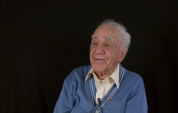7:07 | Emil DeDonata was lucky. He came back from the war and went right back to his old job. He wasn't so lucky readjusting to civilian life. The bed was too soft and even things that should please him caused him stress. It took a falling out with his boss to make him strike out on his own, which led to much success for him.
Keywords : Emil DeDonato advertising Stork Club Madison Avenue Florida

Emil DeDonato was an advertising errand boy when his name appeared on the front page of the New York Times as part of the first draft of 1941. That was in January, and in December, war came to America. Soon, he was being trained for amphibious landings in anticipation of the work that had to be done.
It was November of 1942 when Emil DeDonato landed in North Africa. His job was to get ashore with the first wave and establish communications with the ship. The situation was chaotic but he stuck with it and made it happen. He was awarded the Bronze Star for this action.
After a successful landing and battle in Morocco, Emil DeDonato's unit was just waiting on transportation north to Casablanca. The commander got tired of waiting and decided they would walk, a distance of 283 miles.
Emil DeDonato was assigned to the message center. There were two four-man teams that went forward with the attack force and set up communications. He was part of the push across North Africa to confront Rommel.
At the Battle of El Guettar, the first frontal assault failed. It was nine days before the GIs prevailed and pushed on. Emil DeDonato was shuffling between the front and the rear as part of the communications team. He had to dodge superior German firepower in the form of plentiful aircraft, burp guns, 88mm guns and Screaming Mimis.
His unit was overextended and the order came, get out of there! Emil DeDonato was under fire in Sicily when he organized his men and got them clear of the danger. He didn't know it until after the war, but this got him a cluster for his Bronze Star. It was just another close call like the ones he had in North Africa.
It was D plus four when Emil DeDonato waded ashore at Utah Beach. It was quiet by then and his unit moved inland. When they advanced to Cherbourg and entered a huge German pillbox, they found a bounty of provisions which was appreciated very much, especially the cognac.
The objective was Paris but the push was bogged down. Emil DeDonato was on one side of a French highway and the Germans were on the other. After suffering some of the German artillery, he saw a wave of B-17's come over and pound the enemy. The strikes were a little too close, as it turned out.
The Rhine was a wide river, impossible to cross without a bridge and Emil DeDonato was heading toward a small railroad bridge that had been found. The Americans were slowly moving across the narrow structure and he took the opportunity to search nearby buildings where he made a lucky find. He was lucky again when, further down the road, German civilians welcomed the GI's.
In the Belgian town of Verviers, American GI's were being hosted by the townspeople. Emil DeDonato was enjoying the beautiful Belgian girls, but a few days later, he was rushing to join the Battle of the Bulge in the middle of a frigid winter.
The message center was a vital part of battlefield communications. Emil DeDonato was constantly training the junior members of the team, which could be working far in the rear or right on the front. Near the Elbe River, he encountered two Russian soldiers who were trying to take a cow from some German civilians. He stepped in and soon everyone was happy.
Emil DeDonato was only an hour or so away from Berlin when his unit was ordered to stop there and wait. It would be many days before the Russian Army could claim the privilege of entering the German capital. Once it was all over, he was at the top of the list to go home because of his points. There was just one problem. He didn't want to go.